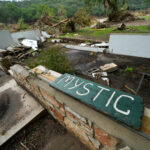Colorado State University’s annual benchmark forecast for Atlantic hurricanes is unlikely to change significantly when it is updated June 1, CSU hurricane expert Phil Klotzbach said May 19, as the increasing likelihood of moderate to strong El Nino conditions in the Pacific reinforces the original prediction of a season of relatively few storms.
There is increasing evidence over the past few years, along with the expected below-normal activity this year, that may indicate the close of a 20-year period in which active hurricane seasons were the norm.
“The environment is as nonconducive for hurricanes as we’ve ever seen,” research scientist Klotzbach told a crowd of about 150 actuaries at a session titled “Predicting Hurricanes” at the Casualty Actuarial Society (CAS) Spring Meeting in Colorado Springs.
Property and casualty actuaries monitor hurricane activity closely, as losses from them are a major driver of property insurance rates.
Many property actuaries work with catastrophe models, which attempt to estimate how much insured loss a hurricane will cause. At the session, Prasad Gunturi, a senior vice president at Willis Re, discussed how catastrophe modelers try to forecast medium- and long-term storm frequency.
Every April, Colorado State forecasts the number of tropical storms, hurricanes and severe hurricanes for the June-to-November season, then makes updates in early June, July and August. The 2015 forecast of storms is likely to increase by one, Klotzbach said, to account for May’s Tropical Storm Ana. Updating the prediction for Ana would mean the forecast predicts eight named storms, three hurricanes and one major hurricane with winds of 111 miles per hour or greater.
That doesn’t mean coastal residents and insurers can relax. In 1992, the founder of CSU’s seasonal forecasts, William Gray, correctly predicted just one major hurricane. That storm, Hurricane Andrew, struck the Miami area with Category 5 winds and became, at the time, the most destructive event in insurance history.
“It just takes that one storm to make it an active season,” Klotzbach reinforced, which is a message that bears remembering as the United States hasn’t been struck by a major hurricane since Hurricane Wilma in 2005 – a record stretch.
An active season needs warmer-than-normal water in the tropical Atlantic. These warmer waters provide more fuel for developing hurricanes. They also create a more unstable atmospheric environment, thereby promoting thunderstorm development, which helps sustain hurricanes.
An anticipated moderate to strong El Nino, the warming of Pacific waters near the equator, reinforces the mild-season prediction. The warm waters create stronger upper-level winds, which “tear apart” storms and forestall hurricane development, he said.
If the forecast proves out, 2015 will be the third straight year of mild hurricane activity. This would be a large anomaly given the Atlantic is considered to be in a 20-plus-year era in which active seasons are the norm. The lull has caused scientists to ask whether the active Atlantic hurricane era has come to an end. The North Atlantic has gotten colder over the past decade and ocean salinity appears to be dropping, both of which would indicate that lower hurricane activity may be in store for the Atlantic basin.
Still, Klotzbach said, other active storm eras have had fallow periods like this one. And he noted that the active/inactive rubric really doesn’t apply to storms forming in the Gulf of Mexico or hitting the Gulf States. Storms that form in the Gulf are governed by a different dynamic.
“Your odds of Gulf landfall and Gulf formation don’t really change,” in an inactive period. The odds of landfall decrease significantly along the Florida Peninsula and East Coast, however.
In his talk, Gunturi noted that catastrophe models have both short-term and long-term event frequency forecasts. The long-term event frequencies use historical averages, he said, while short-term event frequencies use forecasts of meteorological phenomena like El Nino.
The frequency forecast constitutes part of the models’ event set, a sort of encyclopedia of all storms that have hit, augmented by computer-simulated storms that incorporate the patterns of historical storms.
For their forecasts, Gunturi said, the models split the coastline into a series of gates and predict the frequency and severity of storms at each gate.
The models further include a hurricane windfield module that estimates windspeed at a location for any given storm, accounting for surface roughness, Gunturi said – a measure of how built up an area is. Winds passing over urban areas weaken faster than winds passing over a barren plain.
To estimate insurance losses, the models also include a damage module, which indicates how well a specific building type will withstand any storm.
Short-term event frequency forecasts use a five-year forward-looking time horizon, a standard forecast length in the insurance industry for hurricane, earthquake, and other types of natural peril risks, Gunturi observed.
Source: CAS
Was this article valuable?
Here are more articles you may enjoy.

 Twice Injured Firefighter Loses Second Workers’ Compensation Claim
Twice Injured Firefighter Loses Second Workers’ Compensation Claim  Marijuana’s Move to Schedule III: What it Really Means for Cannabis Insurance
Marijuana’s Move to Schedule III: What it Really Means for Cannabis Insurance  Insurance AI Demo Day Calendar Announced
Insurance AI Demo Day Calendar Announced  Texas Camp’s Reopening Draws Outrage, but Some Families Want to Return
Texas Camp’s Reopening Draws Outrage, but Some Families Want to Return 